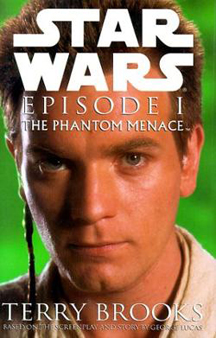At the time of the original trilogy, when home video was in its infancy, novelizations were a way for fans to experience a movie outside of the theater – many a kid carried a tattered and dog-eared copy of “Star Wars” in their backpack the whole school year in 1977. If the novelization had bonus scenes, that was by accident, since the writer had worked from an earlier script rather than the final edit of the film. But by the time of “Episode I: The Phantom Menace” in 1999, novelizations often purposefully gave fans more material than the film provided.
Part of the “bonus material” is an author delving into characters’ head spaces – something that can’t be done in film lest it become bogged down with voiceovers – or selecting more pronounced dialog rather than relying on acting subtleties (yeah, I know, “The Phantom Menace” isn’t a great place to look for Oscar-winning turns anyway). For example, in Terry Brooks’ “Episode I” novelization, 9-year-old Anakin flat out tells 14-year-old Padme he’s going to marry her, and it becomes a running joke between them – this would’ve played more awkwardly in the film than it does in the book.
But Brooks goes beyond that and gives us three new chapters in “The Phantom Menace.” Chapters 1 and 2 chronicle Anakin’s pre-movie Podrace where he damages Watto’s pod and Sebulba wins thanks to various forms of cheating. It also features the boy hanging out with his buddies Kitster and Wald, and the three of them chatting with an old Republic spacer, triggering Anakin’s dreams of being a pilot and a Jedi Knight. Chapter 6 features Anakin trading spare parts for droids with Jawas, and then providing a splint for a Tusken Raider whose leg had been crushed by a rock – an ironic scene considering his “Episode II” encounter with Tuskens.
It’s nice to start off the book with Anakin, who is introduced about 45 minutes into the movie. Although “The Phantom Menace” isn’t written in the first person, or even third-person omniscient, by starting with Anakin, Brooks smartly makes the wide-eyed kid into the audience surrogate.
While those are the only all-new sequences in the book, other sequences get extended. In Chapter 11, the night before the Boonta Eve race, Anakin falls asleep while watching R2 and 3PO paint his Podracer, and he dreams of Padme leading an army. (“I hope not. I hate fighting,” Padme says when Anakin tells her about the dream.)
In Chapter 14, after winning the race, Anakin beats the crap out of a young Rodian who accuses him of cheating. Brooks doesn’t call the Rodian “Greedo,” but popular opinion holds that it is Greedo, making this the first contradiction of the “Tales from the Mos Eisley Cantina” notion that Greedo is young and naïve when Han shoots him. TV’s “The Clone Wars” would later include a teenage Greedo, thus making Greedo middle-aged in “A New Hope” and relegating “Greedo’s Tale” to apocrypha.

Later in that chapter, Anakin’s goodbye scene is expanded to include his best buddy Kitster and the old woman fruit dealer, Jira. Also, Qui-Gon cuts down one of Darth Maul’s probe droids as he and the boy leave Mos Espa, adding tension to their sprint to the queen’s starship before Maul attacks them at the last instant.
Tidbits of information about the makeup of the “Star Wars” galaxy, which Brooks gleaned from phone conversations with George Lucas, were perhaps the biggest hook for fans in 1999. In Chapter 10, Darth Sidious reflects on the history of the Sith, and we are told that “the Sith had come into being almost 2,000 years ago.” This seems to contradict the fact that the “Dark Lords of the Sith” comic is set 4,000 years before the films. Also, we learn that “the Sith who reinvented the order (with the Rule of Two) called himself Darth Bane. A thousand years had passed since the Sith were believed destroyed.” This led to Drew Karpyshyn’s popular “Darth Bane” trilogy.
Chapter 3 features background on the Jedi Order: “In the time of Qui-Gon Jinn, 10,000 Jedi Knights in service to the Republic carried on the struggle each day of their lives on 100,000 different worlds. …” The number 10,000 seems a bit high when I think of Anakin, Obi-Wan and Ahsoka being yanked from one mission to the next in “The Clone Wars” – couldn’t the other 9,998 Knights and their respective Padawans pick up some of the slack?
More pointedly, that number seems high in light of the events in “The Phantom Menace” itself, as the Jedi Council assigns only two Jedi Knights to protect Queen Amidala. Brooks notes that the Jedi, according to their tenets, cannot pick sides in the dispute between the Trade Federation and the Naboo, and this explains why the entire Council sits on their highfalutin rear ends while Qui-Gon and Obi-Wan do the heavy lifting. By contrast, in the comic series “Jedi Council: Acts of War,” the entire Council takes up arms against the Yinchorri. The distinction, perhaps, is that the Yinchorri attacked other planets for the sake of gaining territory whereas the Trade Federation is blockading Naboo to protest the Republic’s new tariffs.
That having been said, the Council knows that the Trade Federation is holding the Naboo citizenry in detention camps. It’s unclear how many Naboo civilians die because of poor conditions (the occupation only lasts a matter of days) or if the Federation murders any of their prisoners. Naboo governor Sio Bibble notes in his transmission to the queen that “the death toll is catastrophic,” but the Neimoidians may have forced him to say that in order to get Amidala to return and sign a treaty legalizing their occupation of Naboo. (Then again, maybe they murdered a catastrophic number of people AND forced Bibble to send the transmission.)
At any rate, I would’ve liked to have seen the Jedi Council cite humanitarian grounds and send hundreds of peacekeeping Jedi to Naboo to ensure the citizenry is being treated humanely by the occupying force. I realize such an action would’ve escalated the conflict, as Sidious would’ve brought in more droid armies. Still, I’ve noticed this conundrum in several novels, too: The Jedi have a humongous peacekeeping force, yet they are absent from many galactic conflicts, raising the question of why they exist as a government-sponsored organization in the first place.
Bonus material gets sparser as “Episode I’s” action enters the four-way Battle of Naboo, but we do learn at the start of Chapter 22 that “the Jedi Master he had trained under” considered Qui-Gon Jinn to be an elite swordsman, and that master had trained students for 400 years. If this is intended to be Yoda, it’s odd that Brooks doesn’t state that flat-out – and it seems unlikely, as Yoda is twice that age. However, as far as I know, none of the EU materials reference Qui-Gon’s lightsaber teacher.
The book concludes with one last controversial nugget. It’s easy to forget 15 years later, but in 1999 there was some controversy about whether Sidious and Palpatine were the same person. The film strongly suggests they are the same person, and it makes no secret that Ian McDiarmid plays both roles. Plus, Sidious dresses and speaks exactly like “Episode VI’s” Emperor, and we know Palpatine will become the Emperor. It seems that “The Phantom Menace” is not presenting Sidious’ identity as a mystery.
However, Brooks never explicitly states that Palpatine and Sidious are the same person, meaning that a theoretical reader who comes into this book completely ignorant of “Star Wars” lore couldn’t help but see them as distinct characters. And in the final chapter, the author has Palpatine attend Qui-Gon’s funeral on Naboo, then has Sidious reflecting as he looks out upon the city lights of (what is suggested to be, but not explicitly stated as) Coruscant, then has Palpatine present at the Naboo parade. Since even a Sith Lord can’t be on two sides of the galaxy at once, some fans felt this sequence of events was a hint that Sidious and Palpatine were not the same person and that we’d be in for a shock in “Episode II.” In retrospect, we have to chalk it up as a writing and editing mistake.
While Brooks’ novel doesn’t rise to the level of the novelization gold standard, Matthew Stover’s “Episode III,” it still gives us significantly more insight into “Episode I” than what we see on screen.

